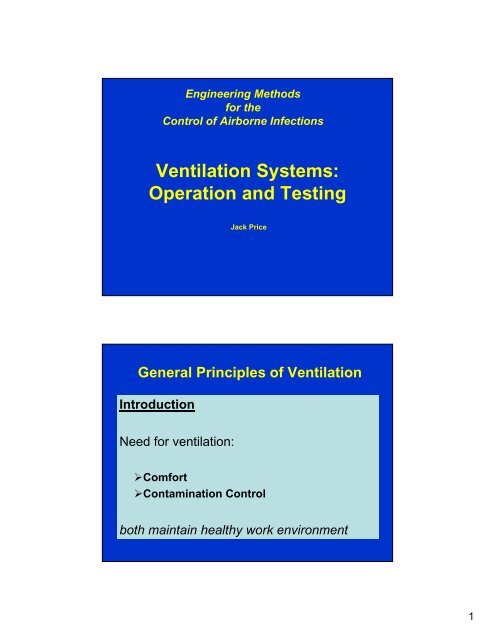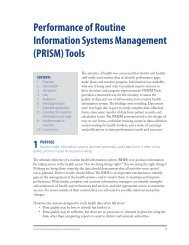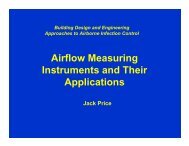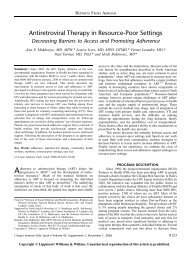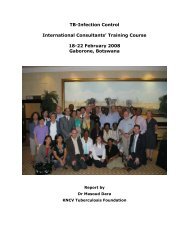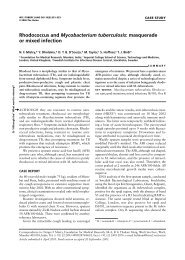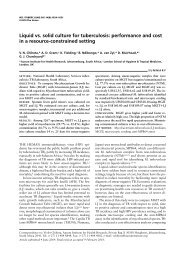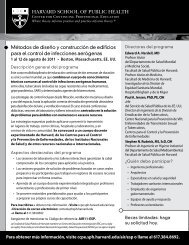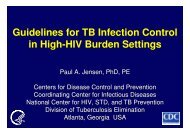Ventilation Systems: Operation and Testing - GHDonline
Ventilation Systems: Operation and Testing - GHDonline
Ventilation Systems: Operation and Testing - GHDonline
Create successful ePaper yourself
Turn your PDF publications into a flip-book with our unique Google optimized e-Paper software.
Engineering Methods<br />
for the<br />
Control of Airborne Infections<br />
<strong>Ventilation</strong> <strong>Systems</strong>:<br />
<strong>Operation</strong> <strong>and</strong> <strong>Testing</strong><br />
Jack Price<br />
General Principles of <strong>Ventilation</strong><br />
Introduction<br />
Need for ventilation:<br />
‣Comfort<br />
‣Contamination Control<br />
both maintain healthy work environment<br />
1
General Principles of <strong>Ventilation</strong><br />
• Office buildings ----- In-door air quality<br />
• Occupational exposure ---- OSHA<br />
• Environmental releases ---- EPA<br />
General Principles of <strong>Ventilation</strong><br />
• Regulatory Agencies (compliance concerns):<br />
• Federal<br />
• State<br />
• Local<br />
• Good Practice<br />
• St<strong>and</strong>ard of care (industry st<strong>and</strong>ards ANSI, ASME, etc.)<br />
• Work productivity<br />
• Process control<br />
2
Types of <strong>Systems</strong><br />
• Supply<br />
Temperature & Humidity<br />
Replacement (make-up air)<br />
Return (recirculated air)<br />
• Exhaust<br />
General (dilution)<br />
Local Control (hoods)<br />
HVAC <strong>Systems</strong><br />
Air H<strong>and</strong>ling System with Economizer<br />
Air Balance in a Conditioned Space<br />
3
Design Concerns<br />
• Temperature<br />
• Pressure<br />
• Air Contaminants<br />
• Work Practices<br />
• Product Protection<br />
• Worker Protection<br />
• Building Codes<br />
• Equipment Selection<br />
• Energy Conservation<br />
• Maintenance<br />
• Security<br />
• Expansion<br />
Air Conditioning System Water <strong>and</strong> Refrigeration Circuits<br />
5
Factors in the Perception of Air Quality<br />
Conservation of Mass<br />
1 velocity = 50 FPM<br />
Hood<br />
2 velocity = 3000 fpm<br />
Air Flow<br />
Duct<br />
Q = V . A<br />
Where<br />
Flow rate at point 1 is called Q 1<br />
<strong>and</strong> is equal to<br />
flow rate at point 2 which is called Q 2<br />
Q = Volumetric Flow Rate, ft 3 /min<br />
V = Air Velocity, ft/min or fpm<br />
A = Cross Sectional Area, ft 2 or SF<br />
6
Q = V . A<br />
Conservation of Mass<br />
8 inch duct<br />
1<br />
12 inch duct<br />
3<br />
6 inch duct<br />
2<br />
Q 1 + Q 2 = Q 3<br />
V 1 A 1 + V 2 A 2 = V 3 A 3<br />
AIR FLOW<br />
• At st<strong>and</strong>ard temperature <strong>and</strong> pressure (STP):<br />
* 1 atmosphere & 70 o F *<br />
The density of air is 0.075 lb m /ft 3<br />
• Air will flow from a higher pressure region to a<br />
lower pressure region<br />
• Three Different Types of Pressure Measurements<br />
* Static * Velocity * Total *<br />
7
Types of Pressure Measurements<br />
• Static Pressure (S P )<br />
potential energy<br />
can be + or –<br />
bursting or collapsing<br />
measured perpendicular to flow<br />
• Velocity Pressure (V P )<br />
kinetic energy<br />
accelerates from 0 to some velocity<br />
Exerted in direction of flow always +<br />
• Total Pressure (T P )<br />
combined static & velocity components<br />
can be + or -<br />
measure of energy content of air stream<br />
Always decreasing as flow travels<br />
downstream thru a system only rising when<br />
going across a fan<br />
TP = SP + VP<br />
TP<br />
_<br />
+<br />
SP<br />
_<br />
+<br />
VP<br />
+<br />
8
Conservation of Energy<br />
• TP = SP + VP or<br />
T P = S P + V P<br />
• Energy losses:<br />
– Acceleration of air<br />
– Hood entry<br />
– Duct losses: friction (function of system materials & design)<br />
– Fitting losses: contractions & expansions<br />
• T P1 = T P2 + h L<br />
now substitute T P = S P + V P<br />
• S P1 + V P1 = S P2 + V P2 + h L<br />
Bench Grinder Hood<br />
Pressure Graphs for TP, SP, <strong>and</strong> VP<br />
9
Velocity Pressure & Velocity<br />
• V = 1096 (V P /p) 0.5<br />
where p = air density<br />
@ STP p = 0.075 lb m /ft 3<br />
• V = 4005 (V P ) 0.5<br />
• Velocity pressure is a function of the velocity <strong>and</strong><br />
fluid density.<br />
• Velocity pressure will only be exerted in the direction<br />
of air flow <strong>and</strong> is always positive.<br />
Bench Grinder Exhaust <strong>Ventilation</strong><br />
1<br />
Duct diameter = 3 inches<br />
Area = 0.0668 ft 2<br />
2 3<br />
• Q 1 = Q 2<br />
• If Q desired is 300 cfm<br />
• Then Q = V A<br />
V = Q A<br />
V = (300) / (0.0068)<br />
V = 4490 fpm<br />
• If there are no losses from the<br />
grinder hood entry then:<br />
SP 1 + VP 1 = SP 2 + VP 2<br />
but: SP 1 = 0 <strong>and</strong> VP 1 0<br />
we then have:<br />
0 = SP 2 + VP 2<br />
or -VP 2 = SP 2<br />
10
Bench Grinder Exhaust <strong>Ventilation</strong><br />
1<br />
Duct diameter = 3 inches<br />
Area = 0.0668 ft 2 V = 4490 fpm<br />
2 3<br />
• If there are no losses from the<br />
grinder hood entry then:<br />
SP 1 + VP 1 = SP 2 + VP 2<br />
but: SP 1 = 0 <strong>and</strong> VP 1 0<br />
we then have:<br />
0 = SP 2 + VP 2<br />
or SP 2 = (-VP 2 )<br />
• from V = 4005 (V P ) 0.5<br />
• VP 2 = (4490/4005) 2<br />
• VP 2 = 1.26 in w.g.<br />
• then: SP 2<br />
= (-VP 2<br />
)<br />
SP 2<br />
= -1.26 in w.g.<br />
Bench Grinder Exhaust <strong>Ventilation</strong><br />
1<br />
S Ph<br />
Duct diameter = 3 inches<br />
Area = 0.0668 ft 2 V = 4490 fpm<br />
2 3<br />
• However there are losses thru the grinder hood entry<br />
S P2 = (-V P2 + h e ) where h e is the energy loss of the hood entry<br />
• Static pressure (S P ) must decrease due to acceleration of air up to the duct velocity<br />
• F h is defined as the energy loss coefficient<br />
• Energy losses will be measured as a function of the velocity pressure in the system<br />
h e = (F h ) (VP)<br />
• Now we define the static pressure at the hood as S Ph<br />
• S Ph is also called the hood static suction <strong>and</strong> is the absolute value of S P2<br />
11
Flanged Inlet with Fd = 0.49<br />
Flanged Inlet with F d<br />
= 0.49<br />
12
Hood Entry Coefficients<br />
Actual Flow<br />
C e = Hypothetical Flow no losses<br />
(4005) (V P ) 0.5 (A) (V P ) 0.5<br />
C e = =<br />
(4005) (S Ph ) 0.5 (A) (S Ph ) 0.5<br />
C e = (V P /S Ph ) 0.5<br />
Hood Entry Coefficients<br />
C e = (V P /S Ph ) 0.5<br />
Typical values for C e are known for some hoods.<br />
For the bench grinder hood with a straight take-off :<br />
C e = 0.78<br />
13
Example Problem<br />
• What static pressure (S Ph ) should be set at<br />
the bench grinder hood to maintain a duct<br />
velocity of 4000 fpm if the take-off duct<br />
size is 4 inch diameter ?<br />
• What is the volumetric flow rate ?<br />
Example Problem<br />
• V = 4000 fpm Q = VA = 4005(A)(V P<br />
) 0.5 Q = VA = 348 cfm<br />
• A for 4 inch duct diameter = 0.087 ft 2<br />
• C e<br />
bench grinder hood = 0.78<br />
V = 4005 (V P<br />
) 0.5<br />
C e = (V P /S Ph ) 0.5 = 0.78<br />
(VP) 0.5 = (4000)/(4005)<br />
(V P /S Ph ) = (0.78) 2<br />
V P<br />
= 0.998 in w.g.<br />
S Ph = V P /(0.78) 2 = (0.998)/(0.608) = 1.64 in w.g.<br />
14
Air Flow Characteristics<br />
• See Industrial <strong>Ventilation</strong> Manual notes<br />
Blowing vs. Exhausting<br />
Air Flow Characteristics<br />
Exhaust Hoods<br />
Capture Velocity<br />
From Dalla Valle’s<br />
empirical work<br />
V (x ) = Q/ (10 x 2 + A)<br />
15
Capture Velocity<br />
V (x) = Q/ (10 X 2 + A)<br />
Capture velocity is<br />
only effective in the<br />
immediate vicinity<br />
of the hood<br />
Room supply air (makeup<br />
air) discharge can<br />
influence effectiveness<br />
of hood capture<br />
Questions ?<br />
16


